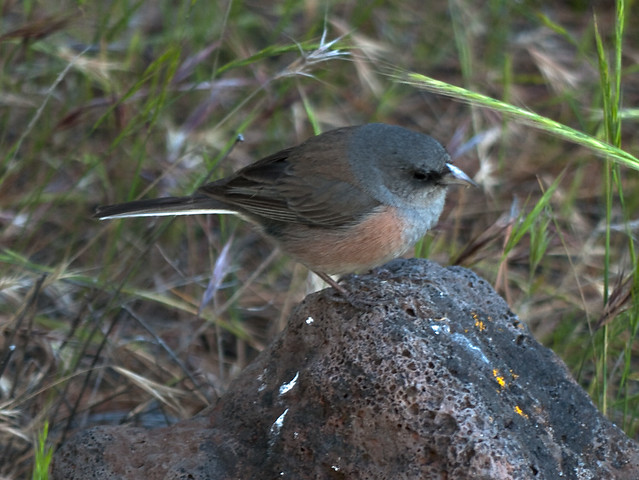Junco insularis Cladus: Eukaryota Name Junco insularis Ridgway, 1876 References * IUCN link: Junco insularis Ridgway, 1876 (Critically Endangered). The Guadalupe Junco, Junco hyemalis insularis, is a bird endemic to Guadalupe Island off Pacific Mexico. It is often considered a subspecies of the Dark-eyed Junco, for example by the IUCN which lumps these taxa in the 2008 IUCN Red List.[2] Other sources treat it as a distinct species Junco insularis.
This American sparrow has a dull grayish head with a gray bill and brownish upperparts. Its wings and tail are blackish, though the tail has white edges. Its underparts are white with a rufous fringe at the bottom of the wings. It makes a high, sharp sik and a long series of chipping notes. This bird is today found mainly in the Cupressus guadalupensis cypress grove on the island of Guadalupe, with a few birds in the remaining Guadelupe Pine stands. Around 1900, it was known to utilize almost any habitat for breeding. It ranged over the whole island for feeding then, and indeed still does theoretically, but actually only a handful of flocks exist. A testimony to the adaptability of this junco is the fact that today a few birds breed at the seashore in non-native Nicotiana glauca tobacco shrub since this is dense enough to provide some protection from cats.[3] The breeding season is from February to June. Three to four eggs are laid in a bulky cup nest of dried grass stems, which is either in a depression in the ground or in the lower branches of a tree. The eggs are greenish white with reddish brown spots. If food is plentiful, the birds apparently breed twice a year.[4] Decline to near-extinction This bird used to be abundant, but now only 50-100 adult birds are thought to survive. Goats introduced to provide food for fishermen and to start a meat-canning plant in the early-mid 19th century became feral and overran the island towards the late 19th century, with more than 4 goats/ha (nearly 2 per acre) being present around the 1870s.[5] Feral cats also multiplied, and as the habitat was destroyed by the goats the cats wreaked havoc on the endemic fauna.[6] In 1897, Kaeding found the Guadalupe Junco "abundant", but already decreasing due to cat predation.[7] Anthony summed up 10 years of occasional visits in 1901 by noting that "...the juncos are slowly but surely becoming scarce."[6] He blamed the interaction of goats, destroying habitat, and cats, destroying the birds themselves. W. W. Brown Jr., H. W. Marsden and Ignacio Oroso surveyed Guadalupe throughout May/June 1906, and collected numerous bird specimens for the Thayer Museum - among these a "large series" of the junco.[8] They found the junco "fairly abundant" but despite the depredations of the cats still "a very tame, confiding little bird" - in other words, unwary of predators. Feral goats were all but exterminated by 2006 by Grupo de Ecologia y Conservacion de Islas and Island Conservation, [1] permitting spectacular regeneration of the native flora. The island was recently protected as a biosphere reserve again by the above groups. As habitat regenerates and especially if the planned removal or containment of cats will be undertaken, the remaining juncos will find more protected breeding and feeding sites. Indeed, the future of the Guadalupe Junco looks better than it ever did during the last century, although it is still precariously close to extinction and could be wiped out by any chance event such as a violent storm or an introduced disease. As noted above, in 2008 the IUCN stopped listing this bird in its Red List, which only contains distinct species.[2] Previously, it was listed as Critically Endangered.[9] Footnotes 1. ^ Species changing IUCN Red List.
* Anthony, A.W. (1901): The Guadalupe Wren. Condor 3(3): 73. PDF fulltext Source: Wikipedia, Wikispecies: All text is available under the terms of the GNU Free Documentation License |
|

